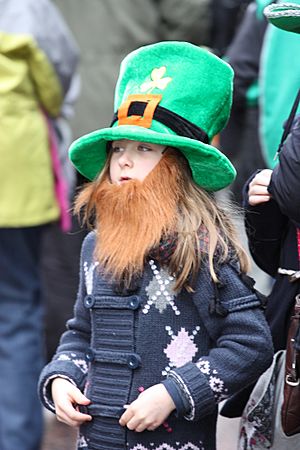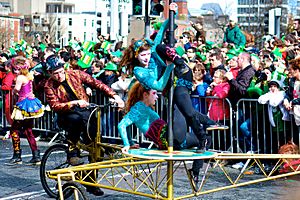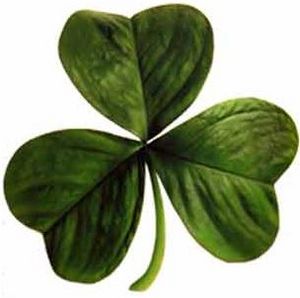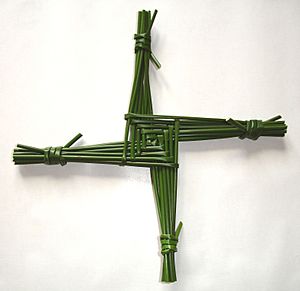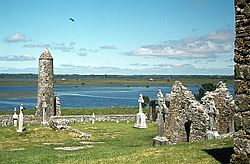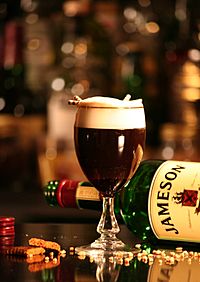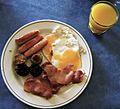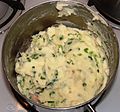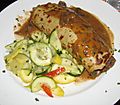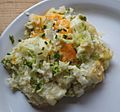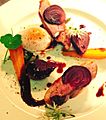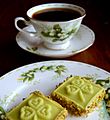Culture of Ireland facts for kids
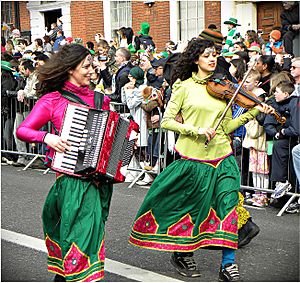
The culture of Ireland includes customs and traditions, language, music, art, literature, folklore, cuisine and sports associated with Ireland and the Irish people.
For most of its recorded history, Ireland's culture has been primarily Gaelic. It has also been influenced by Anglo-Norman, English and Scottish culture. The Anglo-Normans invaded Ireland in the 12th century, while the 16th/17th century conquest and colonization of Ireland saw the emergence of the Anglo-Irish and Scots-Irish (or Ulster Scots).
Today, there are notable cultural differences between those of Catholic and Protestant (especially Ulster Protestant) background. Due to large-scale emigration from Ireland, Irish culture has a global reach and festivals such as Saint Patrick's Day and Halloween, are celebrated all over the world.
Though there are many unique aspects of Irish culture, it shares substantial traits with those of Britain, other English-speaking countries, other predominantly Catholic European countries, and the other Celtic nations.
Contents
Holidays and festivals
The majority of the Irish calendar today still reflects the old pagan customs, with later Christian traditions also having significant influences. Christmas in Ireland has several local traditions, some in no way connected with Christianity. On 26 December (St. Stephen's Day), there is a custom of "Wrenboys" accompanied by strolling musicians going door to door in disguise.
It is believed to go back hundred of years and is still practiced today. The group goes door to door entering private and/or public houses as they' hunt the wren' (pronounced 'ran') entertaining the gathering in exchange for food, drink. The tradition of Hunting the Wren is rich and varied. Historically, a wren was captured and thought to bring good luck for the new year. Another legend has it that the wren was the cleverest bird of all.
Birds hold a special place in the Celtic imagination and in Celtic mythology the the tiny wren holds powerful sway. Some believe the word "dreoilín" (Gaelic for "wren") has its roots in the term "Druid's bird" and that it acted as as messenger between this world and the next.
The national holiday in the Republic of Ireland is Saint Patrick's Day, that falls on the date 17 March and is marked by parades and festivals in cities and towns across the island of Ireland, and by the Irish people around the world. The festival is in remembrance to Saint Patrick, the patron saint of Ireland.
Legend credits Patrick with the banishing of the snakes from the island which is a metaphor being as serpents are symbols of evil in the Judeo-Christian tradition—the Bible. The animals were also linked to heathen practices—so St. Patrick's dramatic act of snake eradication can be seen as his Christianizing influence which credits Patrick with teaching the Irish about the concept of the Trinity by showing people the shamrock, a 3-leaved clover, using it to highlight the Christian belief of 'three divine persons in the one God'.
When Patrick drives the snakes out of Ireland, it is symbolically saying he drove the old, evil, pagan ways out of Ireland and brought in a new age.
In Northern Ireland on The Twelfth of July, commemorates William III's victory at the Battle of the Boyne is a public holiday. The holiday is celebrated by Irish Protestants the vast majority of whom live in Northern Ireland and is notable for the numerous parades organized by the Orange Order which take place throughout Northern Ireland.
These parades are colourful affairs with Orange Banners and sashes on display and include music in the form of traditional songs such as The Sash and Derry's Walls performed by a mixture of Pipe, Flute, Accordion, and Brass marching bands.
Brigid's Day (1 February, known as Imbolc or Candlemas) also does not have its origins in Christianity, being instead another religious observance superimposed at the beginning of spring. The Brigid's cross made from rushes But today many materials are used. Any material that is used for making the cross should ideally be blessed. St. Brigid's day represents a pre-Christian solar wheel.
Other pre-Christian/Celtic festivals, whose names survive as Irish month names, are Bealtaine (May), Lúnasa (August) and Samhain (November). The last is still widely observed as Halloween which is celebrated all over the world, including in the United States followed by All Saints' Day, another Christian holiday associated with a traditional one. Important church holidays include Easter, and various other Christian observances.
Religion
Christianity in the form of both Roman Catholicism and Protestantism is the most widely practised religion in Ireland. Christianity was brought to Ireland during or prior to the 5th century and its early history among the Irish is in particular associated with Saint Patrick, who is generally considered Ireland's patron saint. The Celtic festival of Samhain, known as Halloween, originated in Ireland and is now celebrated all over the world. Ireland is a place where religion and religious practice have always been held in high esteem.
Folklore
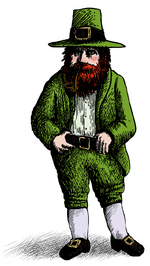
The Leprechaun is very prominent in Irish folklore. According to the tales, the leprechaun is a mischievous fairy type creature in emerald green clothing who when not playing tricks spend all their time busily making shoes, the Leprechaun is said to have a pot of gold hidden at the end of the rainbow, and if ever captured by a human it has the magical power to grant three wishes in exchange for release.
More acknowledged and respected in Ireland are the stories of Fionn mac Cumhaill. Legend has it he built the Giant's Causeway as stepping-stones to Scotland, so as not to get his feet wet; he also once scooped up part of Ireland to fling it at a rival, but it missed and landed in the Irish Sea — the clump became the Isle of Man and the pebble became Rockall, the void became Lough Neagh.
The Irish king Brian Boru who ended the domination of the so-called High Kingship of Ireland by the Uí Néill, is part of the historical cycle. The many legends of ancient Ireland were written by Lady Gregory in two volumes with forwards by W.B. Yeats. These stories depict the unusual power and status that Celtic women held in ancient times.
Halloween is a traditional and much celebrated holiday in Ireland on the night of 31 October. The name Halloween is first attested in the 16th century as a Scottish shortening of the fuller All-Hallows-Eve, and according to some historians it has its roots in the gaelic festival Samhain, where the Gaels believed the border between this world and the otherworld became thin, and the dead would revisit the mortal world.
In Ireland, traditional Halloween customs include; — children disguised in costume going from door to door requesting food or coins – which became practice by the late 19th century, turnips hollowed-out and carved with faces to make lanterns, holding parties where games such as apple bobbing are played. Other practices in Ireland include lighting bonfires, and having firework displays. Mass transatlantic Irish and Scottish immigration in the 19th century popularised Halloween in North America.
Literature and the arts
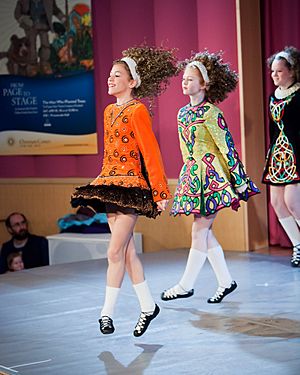
For a comparatively small place, the island of Ireland has made a large contribution to world literature in all its area's. Particularly famous examples of such works are those of James Joyce, Bram Stoker, Jonathan Swift, Oscar Wilde and Ireland's four winners of the Nobel Prize for Literature; William Butler Yeats, George Bernard Shaw, Samuel Beckett and Seamus Heaney.
Three of the four Nobel prize winners were born in Dublin, making it the birthplace of more Nobel literary laureates than any other city in the world. The Irish language has the third oldest literature in Europe and the most significant body of written literature (both ancient and recent) of any Celtic language, as well as a strong oral tradition of legends and poetry. Poetry in Irish represents the oldest poetry in Europe, with the earliest examples dating from the 6th century.
The early history of Irish visual art is generally considered to begin with early carvings found at sites such as Newgrange and is traced through Bronze age artefacts, particularly ornamental gold objects, and the Celtic brooches and illuminated manuscripts the early Medieval period. During the course of the 19th and 20th centuries, a strong indigenous tradition of painting emerged, including such figures as John Butler Yeats, William Orpen, Jack Yeats and Louis le Brocquy.
The Irish tradition of folk music and dance is also widely known. In the middle years of the 20th century, as Irish society was attempting to modernise, traditional Irish music fell out of favour to some extent, especially in urban areas. Young people at this time tended to look to Britain and, particularly, the United States as models of progress and jazz and rock and roll became extremely popular.
During the 1960s, and inspired by the American folk music movement, there was a revival of interest in the Irish tradition The annual Fleadh Cheoil na hÉireann is the largest festival of Irish music in Ireland.
Before long, groups and musicians like Horslips, Van Morrison and even Thin Lizzy were incorporating elements of traditional music into rock to form a unique new sound. During the 1970s and 1980s, the distinction between traditional and rock musicians became blurred, with many individuals regularly crossing over between these styles of playing. This trend can be seen more recently in the work of bands like U2, Snow Patrol, The Cranberries, The Undertones and The Corrs.
- Irish Nobel Prize in Literature laureates
| W.B. Yeats (1865–1939) |
George Bernard Shaw (1856–1950) |
Samuel Beckett (1906–1989) |
Seamus Heaney (1939–2013) |
|---|---|---|---|
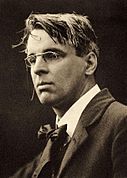 |
 |
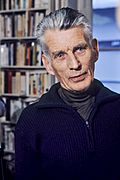 |
 |
Languages

Irish and English are the most widely spoken languages in Ireland. English is the most widely spoken language on the island overall, and Irish is spoken as a first language only by a small minority. A larger minority speak Irish as a second language, with 40.6% of people in the Republic of Ireland claiming some ability to speak the language.
Several other languages are spoken on the island, including Shelta, a mixture of Irish, Romany and English, spoken widely by Travellers. Two sign languages have also been developed on the island.
Some other languages have entered Ireland with immigrants – for example, Polish is now the second most widely spoken language in Ireland after English, Irish being the third most commonly spoken language.
- Irish Gaelic Language
- Irish Sign Language
- Hiberno-English
- Ulster Scots language
- Mid-Ulster English
- Northern Ireland Sign Language
- Shelta language
Food and drink
Early Ireland

There are many references to food and drink in early Irish literature. Honey seems to have been widely eaten and used in the making of mead. The old stories also contain many references to banquets, although these may well be greatly exaggerated and provide little insight into everyday diet. There are also many references to fulacht fia, which are archaeological sites commonly believed to have once been used for cooking venison. The fulacht fia have holes or troughs in the ground which can be filled with water. Meat can then be cooked by placing hot stones in the trough until the water boils. Many fulach fia sites have been identified across the island of Ireland, and some of them appear to have been in use up to the 17th century.
Excavations at the Viking settlement in the Wood Quay area of Dublin have produced a significant amount of information on the diet of the inhabitants of the town. The main animals eaten were cattle, sheep and pigs, with pigs being the most common. This popularity extended down to modern times in Ireland. Poultry and wild geese as well as fish and shellfish were also common, as were a wide range of native berries and nuts, especially hazel. The seeds of knotgrass and goosefoot were widely present and may have been used to make a porridge.
The potato in Ireland
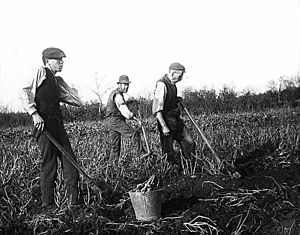
The potato would appear to have been introduced into Ireland in the second half of the 16th century, initially as a garden crop. It eventually came to be the main food field crop of the labouring classes. As a food source, the potato is extremely efficient in terms of energy yielded per unit area of land. The potato is also a good source of many vitamins and minerals, particularly vitamin C (especially when fresh).
As a result, the typical 18th- and 19th-century Irish diet of potatoes and buttermilk was a contributing factor in the population explosion that occurred in Ireland at that time. However, due to the political rule of the time, the majority of Irish produce (root crops, cereals and animal produce) was exported to Britain, leaving few strains of potato as the sole food source for the Irish.
This, along with the spread of potato blight led to shortages and famine, the most notable instance being the Great Irish Famine (1845–1849), which more or less undid all the growth in population of the previous century. The cause of which was partially due to an adherence to economic policies by the government which kept food exports at the pre famine level leading to disease and emigration.
Modern times
In the 20th century the usual modern selection of foods common to Western cultures has been adopted in Ireland. Both US fast-food culture and continental European dishes have influenced the country, along with other world dishes introduced in a similar fashion to the rest of the Western world. Common meals include pizza, curry, Chinese food, and lately, some west African dishes have been making an appearance. Supermarket shelves now contain ingredients for, among others, traditional, European, American (Mexican/Tex-Mex), Indian, Polish and Chinese dishes.
The intrduction of fast food has led to increasing public health problems including obesity, and one of the highest rates of heart disease in the world. In the Northern Ireland, the Ulster fry has been particularly cited as being a major source for a higher incidence of cardiac problems, quoted as being a "heart attack on a plate". All the ingredients are fried, although more recently the trend is to grill as many of the ingredients as possible.
In tandem with these developments, the last quarter of the century saw the emergence of a new Irish cuisine based on traditional ingredients handled in new ways. This cuisine is based on fresh vegetables, fish, especially salmon and trout, oysters and other shellfish, traditional soda bread, the wide range of hand-made cheeses that are now being made across the country, and, of course, the potato. Traditional dishes, such as the Irish stew, Dublin coddle, the Irish breakfast and potato bread, have enjoyed a resurgence. Schools like the Ballymaloe Cookery School have emerged to cater for the associated increased interest in cooking with traditional ingredients.
Representative Irish Foods
-
Boxty with beef and squash
-
Seafood chowder
-
Cheese and onion crisps
-
Baileys cheesecake
Images for kids
-
A typical Irish pub in County Donegal
-
Institute of Education and Celtic Culture, Dingle, County Kerry, Ireland
See also
 In Spanish: Cultura de Irlanda para niños
In Spanish: Cultura de Irlanda para niños


